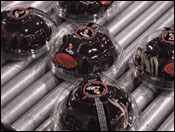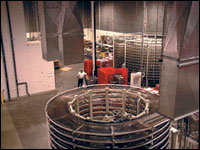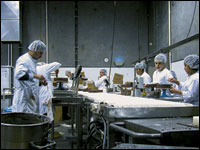
The husband and wife were part of San Francisco’s Haight-Ashbury scene in the early 1970s when a friend suggested Elliot start supplying his restaurant with New York style cheesecakes. Sales took off, and in 1974 the couple sold their VW Bug to buy a 20-qt. mixer. Just Desserts was born, and over the next quarter century it would grow to include 10 retail bakeries and a production facility employing 140.
“The plant wasn’t up to food safety standards and couldn’t be renovated to meet them,” says Hoffman, the firm’s president. “Knowing that we needed a new facility, we set out two years ago and found a piece of dirt in the inner city of Oakland, just as our old plant was in the inner city of San Francisco.” While the old bakery was a 31,000 sq. ft. honeycomb of rooms, the new plant is a 65,000 sq. ft. facility that accommodates a logical production flow and a quantum improvement in production processes.
The plant was built on a 4-acre parcel that was part of a 65-acre brownfield reclamation project. Horvath and Hoffman began working with E.A. Bonelli & Associates, an Oakland A/E firm that works extensively in the food industry, and process engineers Ginosko Inc. in spring 2000. The objective was to design and build a plant that could earn a superior rating from American Institute of Baking auditors. In September 2000, financing was secured and the land purchased. Occupancy commenced last August.
Vibrant colors and large circular columns give the plant’s exterior a markedly different look than the typical food manufacturing facility. An acrylic polymer was troweled over Styrofoam plastic panels to create a stucco-like appearance at a fraction of the cost, according to John Schmeidel, Bonelli’s principal architect.

“We had two objectives for this plant,” explains Hoffman: “To build a great food manufacturing facility, and to create a people-friendly place, the kind of bakery where you like to come to work.”

Automation by retrofit
Construction and land-acquisition costs ate up the bulk of the facility’s $12 million budget, forcing the owners to make some equipment concessions. A reconditioned Baker-Perkins oven, for example, was installed, and automated ingredient metering is limited. “Automation was something we allowed for in future upgrades that could be done incrementally, without obsoleting the existing system,” says Randy Cowart, senior project engineering with Ginosko.Operators manually deposit bagged flour into the Mondomix mixers. At some point, bulk flour could be delivered to the mixers and integrated with the Pfenning flow metering system that delivers chilled water, sugar and oil because integration needs are engineered into the design. A master plan for total automation exists, even if the equipment needed to execute it is not fully in place.
Reduced dependence on racks for product handling is one of the new plant’s greatest improvements, according to Ginosko’s Steve Finn, who did most of the process engineering for the facility. “For the making of cakes, it’s almost a continuous process,” he says. “Cakes may never see a rack, depending on how they’re packaged.” That resolves the many storage, sanitation and labor issues endemic to racks.
Rack ovens were used in the old plant, and switching to a 70-ft. tunnel oven with a 12-ft. belt represented a significant process change. “We always held the belief that we could change the process without changing the quality,” Hoffman says. In fact, the hearth oven did change product quality, though in a positive way. “We’re getting much better results, with a much more even bake than we got with the rack ovens,” he points out. The tunnel also boosted capacity to 1,500 cakes per hour, up from 250.
The new bakery also boasts a 50-ft. long automated icing system from Unifiller that completes 12 cakes per minute. “In the old plant, people were icing cakes by hand all day,” Hoffman recalls. “It was carpal-tunnel heaven.”
Group meetings were held with bakery operators, sanitation crews and other workers to solicit suggestions for the new plant. “The general complaint involved the flooring,” Horvath relates. “We couldn’t keep the floors clean in the old plant. We involved our staff in selecting slip-proof flooring for the production areas and acid brick for the sanitation room.” Workers were invited to review the installation process and offer suggestions.
Food-grade wall coverings and a logical product flow are among the new plant’s improvements. Roll-up doors and a flow rack for minor ingredients help ferry materials from the warehouse to the mixing room, where high sheer and paddle mixers prepare meringues and batters. The room is a high washdown environment and is segregated from the production area. After baking, cakes enter a Frigoscandia spiral blast freezer with a freezing capacity of 2,500 lbs. an hour, then enter a 4,133 sq. ft. Freon-powered freezer. “The payback on an ammonia system would probably be 10 years, and there were Hazmat training issues that would have had to be addressed,” says Finn in explaining the Freon selection.
“For 26 years, we baked fresh daily, and we called frozen the F word,” Horvath jokes. “When we began looking for a new facility, we threw a few of our cakes into a freezer and conducted a taste test to compare it with fresh.” To the couple’s surprise, taste testers preferred the previously frozen cakes. That was the genesis of a new business direction for Just Desserts.
Inspired by the success of Ben & Jerry’s, Horvath and Hoffman are baking all-natural, premium cakes for the in-store bakery market. The new plant continues to make fresh cheesecakes and about 100 other pastries and desserts, but 15 cakes made with butter and whole eggs will be the facility’s mainstays.
“Our national rollout is off to a fantastic start,” says Hoffman, and he credits the quality, yield and safety improvements made possible by the new facility for a good measure of that success.